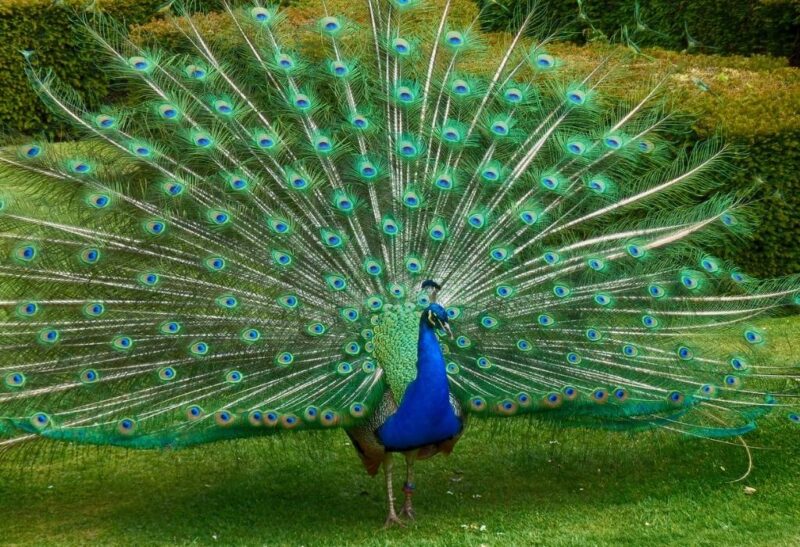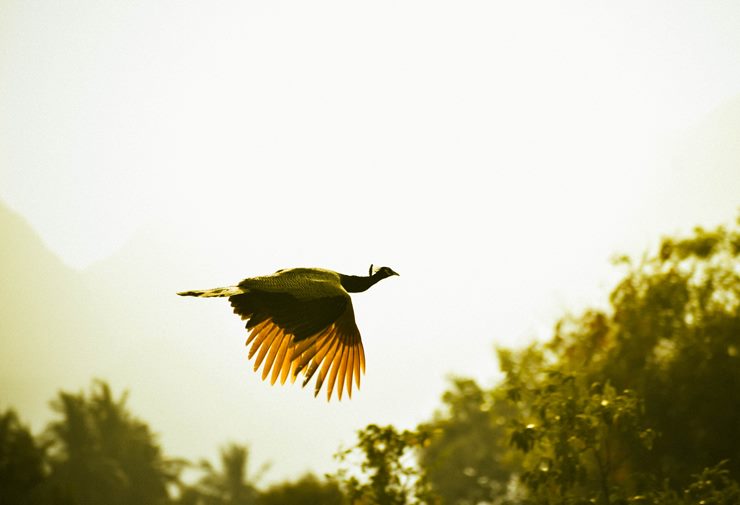Have you ever wondered, "Do peacocks fly?" These stunning creatures, known for their vibrant plumage and mesmerizing displays, often leave us questioning their aerial abilities. While we're used to seeing them strutting around gardens and parks, their flying capabilities might surprise you. So, let's dive into this fascinating topic and uncover the truth about peacocks and their wings.
Peacocks are not just pretty faces—or feathers, should we say. They belong to the pheasant family and are native to regions like India, Sri Lanka, and Africa. Despite their large size and impressive tails, they possess some surprising talents that go beyond their earthbound appearances. If you've ever caught a glimpse of a peacock in action, you'll realize there's more to these birds than meets the eye.
Now, before we get into the nitty-gritty details, let me assure you that this article is packed with facts, insights, and a touch of humor to keep things interesting. Whether you're a bird enthusiast or simply curious about nature's wonders, you're in the right place. So, buckle up and let's explore the world of peacocks and their flying secrets!
Table of Contents
- Peacock Basics: A Quick Bio
- Do Peacocks Fly? The Short Answer
- How High Can Peacocks Fly?
- Why Do Peacocks Fly?
- The Science Behind Peacock Flight
- Physical Traits That Aid Flying
- Debunking Common Myths About Peacock Flight
- Peacock Flight vs Other Birds
- Peacock Habitats and Their Role in Flying
- Conservation Efforts and Peacock Flying
Peacock Basics: A Quick Bio
Peacock Facts You Need to Know
Before we tackle the question of whether peacocks can fly, let's take a moment to appreciate these magnificent birds. Peacocks, scientifically known as Pavo cristatus, are native to the Indian subcontinent and are celebrated for their iridescent tail feathers. These feathers, which can stretch up to six feet, are used primarily for courtship displays.
Interestingly, the term "peacock" refers specifically to the male bird, while females are called peahens, and collectively, they're known as peafowl. Despite their size and weight, peacocks have a surprising set of skills that defy their earthbound appearances.
| Fact | Detail |
|---|---|
| Scientific Name | Pavo cristatus |
| Native Region | India, Sri Lanka, and Africa |
| Weight | 8.7–13 kg (male), 3–4 kg (female) |
| Wingspan | 1.5–1.6 meters |
| Lifespan | 20 years in the wild |
Do Peacocks Fly? The Short Answer
Alright, let's cut to the chase. Do peacocks fly? The short answer is yes, but there's a catch. While peacocks are indeed capable of flight, their flying style is quite different from what you'd expect from other birds. Instead of soaring gracefully through the skies, peacocks use their wings for short bursts of flight, often to reach high perches or escape predators.
Peacocks aren't built for long-distance travel. Their heavy bodies and elaborate tail feathers make sustained flight a challenge. However, their wings are powerful enough to lift them off the ground when needed. So, while they may not win any airshow competitions, peacocks can certainly hold their own in the skies—albeit briefly.
How High Can Peacocks Fly?
Now that we know peacocks can fly, the next question is, how high can they go? Well, peacocks aren't exactly aiming for the stratosphere. Their flights are typically limited to heights of around 10 to 15 feet. This might not sound impressive, but it's more than enough for them to reach tree branches or avoid ground-level threats.
Peacocks use their wings to glide from one perch to another, often roosting in trees at night to stay safe from predators. While they may not reach the heights of eagles or hawks, their ability to navigate their environment is crucial for survival.
Why Do Peacocks Fly?
So, why do peacocks bother flying at all? It turns out, their aerial abilities serve several important purposes. First and foremost, flying helps peacocks escape danger. When faced with a predator, a quick burst of flight can mean the difference between life and death.
Additionally, peacocks use their wings to reach elevated perches, where they can rest safely overnight. This behavior is especially common in areas where ground-dwelling predators are a threat. By taking to the skies, even briefly, peacocks can ensure their safety and well-being.
The Science Behind Peacock Flight
Understanding Peacock Wing Structure
Peacock wings are uniquely adapted for their specific needs. While their tail feathers may seem like a hindrance, their wings are surprisingly powerful. Peacocks have strong muscles that allow them to generate enough lift to become airborne, albeit for short distances.
Their wingspan, which can reach up to 1.6 meters, provides the necessary surface area for flight. However, their heavy bodies and long tails require a lot of energy to lift off the ground. This is why peacocks rely on short, powerful bursts of flight rather than sustained aerial maneuvers.
Physical Traits That Aid Flying
Peacocks possess several physical traits that aid their flying abilities. For starters, their wings are broad and strong, providing the necessary lift for takeoff. Additionally, their lightweight bones help reduce the overall weight of their bodies, making flight more feasible.
Despite their impressive tail feathers, peacocks have a relatively streamlined body shape that minimizes drag during flight. Their feathers also play a role in stabilizing their flight, allowing them to glide smoothly from one perch to another.
Debunking Common Myths About Peacock Flight
There are several myths surrounding peacock flight that need to be addressed. One common misconception is that peacocks cannot fly at all. As we've already established, this simply isn't true. While their flying abilities may not be as impressive as those of other birds, peacocks are fully capable of taking to the skies when necessary.
Another myth is that peacocks only use their wings for show, but this couldn't be further from the truth. Their wings serve a vital purpose in both flight and survival, proving that beauty and functionality can coexist in the animal kingdom.
Peacock Flight vs Other Birds
When comparing peacock flight to that of other birds, it's important to consider the unique challenges they face. Unlike birds like sparrows or pigeons, peacocks have to contend with their heavy tails and large size. This makes their flying style quite different from that of lighter, more agile birds.
That being said, peacocks are far from the only birds with limited flying abilities. Ostriches and emus, for example, are completely flightless, relying on their speed and agility to evade predators. In contrast, peacocks have retained their ability to fly, albeit in a limited capacity.
Peacock Habitats and Their Role in Flying
Peacocks are native to a variety of habitats, including forests, grasslands, and even urban areas. Their ability to fly plays a crucial role in their adaptation to these environments. In forested areas, for example, peacocks use their wings to navigate dense foliage and reach high perches. In urban settings, they may take to the skies to avoid traffic or other hazards.
Regardless of their habitat, peacocks rely on their flying abilities to ensure their survival. Whether it's escaping predators or finding a safe place to rest, their wings are an essential tool in their arsenal.
Conservation Efforts and Peacock Flying
Peacocks are not currently considered endangered, but conservation efforts are still important to ensure their long-term survival. Protecting their natural habitats and raising awareness about their unique traits can help preserve these magnificent birds for future generations.
Understanding their flying abilities is just one aspect of peacock conservation. By studying their behavior and adaptations, we can gain valuable insights into how they interact with their environment and what steps we can take to support their well-being.
Conclusion
In conclusion, the question of whether peacocks can fly has a fascinating answer. While they may not be the most graceful fliers, peacocks possess the ability to take to the skies when needed. Their flying skills, though limited, play a vital role in their survival and adaptation to various environments.
So, the next time you see a peacock strutting around, remember that there's more to these birds than meets the eye. They may not soar like eagles, but their unique combination of beauty and functionality makes them truly remarkable creatures.
If you enjoyed this article, feel free to share it with your friends or leave a comment below. And don't forget to check out our other articles for more fascinating insights into the animal kingdom!


